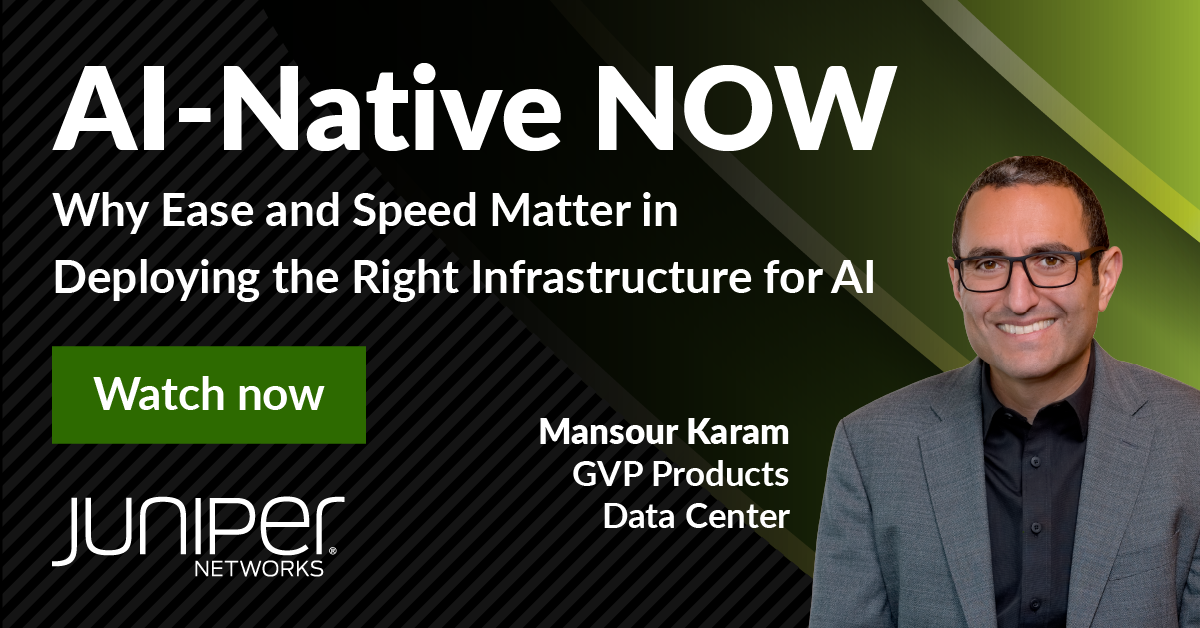New products bring even more agility, automation and assurance to the Juniper® AI Data Center solution
I’ve spent 30 years helping customers address their top networking needs and it seems, regardless of the time or business, the pain points stay the same. Everyone wants to move faster and make their business more competitive. Operations are never simple enough, no matter how automated. And there is never enough budget or resources, so IT departments always have to do more with less.
Occasionally, new technologies emerge that shine a spotlight on these issues. I believe that artificial intelligence (AI) falls into this category. While the promise of AI is astronomical, so too is the cost and complexity of building and operating networks for AI data centers.
Training AI models, for example, is a massively complex parallel processing problem that relies heavily on the network. Building the right network is key to optimizing expensive GPU servers, which can cost hundreds of thousands of dollars.
This week, Juniper expanded on these architectural advantages with new products and capabilities to drive even more speed, efficiency and scale to AI data centers. We’re bringing AIOps to the data center with proactive actions and seamless knowledgebase queries, expanding Juniper® Apstra® for better support of AI/ML workloads, and adding new Juniper Networks® PTX Series Routers, line cards and QFX Series switches for increased scale and reliability.
As a key element of Juniper’s AI-Native Networking Platform, our expanded AI Data Center solution takes much of the complexity out of networking design, deployment and troubleshooting, allowing customers to do more with fewer IT resources. In addition, it delivers unsurpassed flexibility to customers, avoiding vendor lock-in with silicon diversity, multivendor switch management and a commitment to open, standards-based Ethernet fabrics.
Save Time and Money with an Operations-First Approach to Design, Deployment and Troubleshooting
An operations-led approach saves time and money with simplified Day 0/1/2+ operations, using fewer resources. Apstra is the only multivendor data center automation platform with industry-leading intent-based networking to accelerate time to deploy and troubleshoot by avoiding manual configuration challenges. As the single source of truth with closed-loop assurance, Apstra offers powerful analytics to predict and proactively fix problems to avoid service disruptions. With templated blueprints, Apstra delivers reliability, consistency and repeatability that have demonstrated up to a 90% lower OPEX, an 85% faster deployment and a 320% ROI for customers.
With Marvis® Virtual Network Assistant for Data Center, Juniper is now bringing AIOps to this domain to deliver additional automation and insight to optimize data center experiences. Marvis VNA for Data Center extends the rich streaming telemetry and real-time monitoring in Apstra into the Marvis Actions dashboard to provide proactive troubleshooting and analytics across operational domains. This integration is a fundamental first step to providing AI-driven, actionable insights for multivendor data centers. And campus and branch operators already using Marvis can now see data center issues on the same dashboard.
Open, AI-Optimized Ethernet Uses Proven Technology That Avoids Vendor Lock-In
Optimizing GPU efficiency for the lowest job completion time (JCT) is critical to contain AI costs. But historically, the AI networking ecosystem has been built around InfiniBand, a networking technology that is relatively expensive and scarce compared to Ethernet, the most widely deployed L2 technology in the world.
But that’s changing. With the release of PyTorch 2.0, the leading AI developer framework, more GPU vendors are introducing Ethernet-based products that break AI networking’s reliance on InfiniBand. In addition, the Ultra Ethernet Consortium (UEC), of which Juniper is a member, has been put in place to accelerate the development of a common, high-performance Ethernet architecture for multivendor AI networks.
To capitalize on the growing market shift from InfiniBand to Ethernet, this week, Juniper introduced advanced traffic management capabilities to assure high-bandwidth, lossless, low-latency and scalable performance over Ethernet in AI data centers. This delivers performance on par with InfiniBand while leveraging the fact that Ethernet is more economical, assures faster innovation, maximizes design flexibility and avoids supply chain challenges.
The PTX Series routers for data centers have been extended with the new high-density 800GbE PTX10002-36QDD fixed switch and new 800GbE line cards for the PTX10000 chassis. Built on Express 5 custom silicon, the largest PTX10000 chassis now supports up to 576 x 800GbE ports for high radix spine and super spine architectures. In addition, a new high-density 800GbE QFX5240 fixed platform based on the latest Broadcom Tomahawk 5 ASIC offers silicon diversity for high-performance, scalable AI data centers with power efficiency.
To simplify AI deployments, Juniper has new Juniper Validated Designs (JVDs). AI JVDs enable prescribed, rail-optimized or multilayered clos fabrics to assure a complete data center solution, including switching, operations and security. JVD “extensions” include integrations with Juniper’s comprehensive data center security portfolio with unified threat prevention for Zero Trust data center protection. Rigorously tested, validated and documented by Juniper Labs professionals, JVDs can be used as out-of-the-box designs or as a set of guidelines to reduce risk and properly size and budget every AI cluster.
Juniper is excited to push the networking industry forward with the announcement of our unique AI-Native Networking Platform. Our AI-Native Networking Platform continues to lead the industry in AIOps, while our new networking for AI solutions will facilitate mass market adoption and deployment of AI data center infrastructure.
Want to learn more? See first-hand the new products we announced today and learn how AI is reshaping the data center. We’ll take a deep dive into what makes Juniper’s AI-Native Networking Platform tick, and how it delivers better and more personalized experiences for operators and end users.
Register for the on-demand event here.
Statement of Product Direction.Juniper Networks may disclose information related to development and plans for future products, features or enhancements, known as a Statement of Product Direction or Plan of Record (“POR”). These details provided are based on Juniper’s current development efforts and plans. These development efforts and plans are subject to change at Juniper’s sole discretion, without notice. Except as may be set forth in a definitive agreement, Juniper Networks provides no assurances and assumes no responsibility to introduce products, features or enhancements described in this website, presentation, meeting, or publication, nor is Juniper liable for any loss arising out of reliance on the POR. Purchasing decisions by third-parties should not be based on this POR, and no purchases are contingent upon Juniper Networks delivering any feature or functionality described in this website, presentation, meeting, or publication.


























